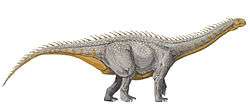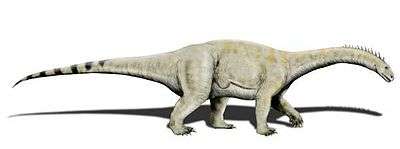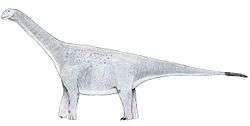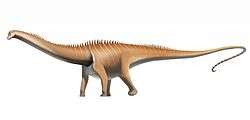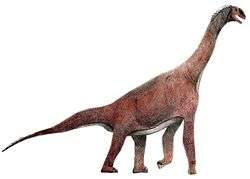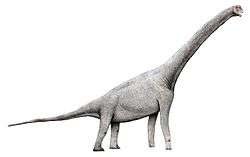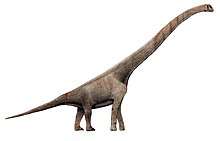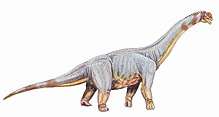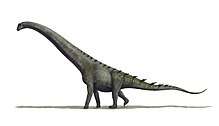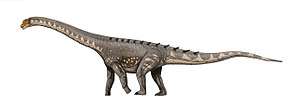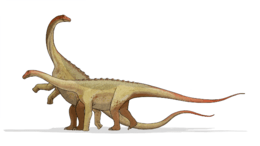Giraffatitan
| Giraffatitan | |
|---|---|
.jpg) | |
| Mounted skeleton, Berlin's Natural History Museum | |
| Scientific classification | |
| Kingdom: | Animalia |
| Phylum: | Chordata |
| Clade: | Dinosauria |
| Order: | Saurischia |
| Suborder: | †Sauropodomorpha |
| Clade: | †Sauropoda |
| Family: | †Brachiosauridae |
| Genus: | †Giraffatitan Paul, 1988 |
| Type species | |
| †Brachiosaurus brancai | |
| Synonyms | |
Giraffatitan, meaning "giant giraffe", is a genus of sauropod dinosaur that lived during the late Jurassic Period (Kimmeridgian–Tithonian stages). It was originally named as an African species of Brachiosaurus (B. brancai) but this has since been changed. Giraffatitan was for many decades known as the largest dinosaur but recent discoveries of several larger dinosaurs prove otherwise: giant titanosaurians appear to have surpassed Giraffatitan in terms of sheer mass. Also the sauropod dinosaur Sauroposeidon is estimated to be taller and possibly heavier than Giraffatitan.
All size estimates for Giraffatitan are based on the specimen HMN SII a subadult individual between 21.8–22.5 metres (72–74 ft) in length and about 12 meters (39 ft) tall. Mass estimates are varied from as little as 15 tonnes (17 short tons) to as much as 78.3 tonnes (86.3 short tons) but there is evidence supporting that these animals could grow larger: specimen HMN XV2, represented by a fibula 13% larger than the corresponding material on HMN SII, which might have attained 26 metres (85 ft) in length or longer.[2]
Description

For many decades, Giraffatitan was claimed to be the largest dinosaur known, (ignoring the possibly larger but lost Amphicoelias) but in the later part of the 20th century several giant titanosaurians appear to have surpassed Giraffatitan in terms of sheer mass. However, Giraffatitan, along with Brachiosaurus are still the largest dinosaurs known from relatively complete material.[3]
All size estimates for Giraffatitan are based on the specimen HMN SII,[3] a subadult individual between 21.8–22.5 metres (72–74 ft) in length and about 12 meters (39 ft) tall.[4][5] Mass estimates are more problematic and historically have varied from as little as 15 tonnes (17 short tons) to as much as 78.3 tonnes (86.3 short tons).[6][7] These extreme estimates are now considered unlikely due to flawed methodologies. More recent estimates based on models reconstructed from bone volume measurements, which take into account the extensive, weight-reducing air sac systems present in sauropods, and estimated muscle mass, are in the range of 23.3–39.5 tonnes (25.7–43.5 short tons).[3][4][8][9] However, HMN SII is not the largest specimen known (an assertion supported by its subadult status) but HMN XV2, represented by a fibula 13% larger than the corresponding material on HMN SII,[3] which might have attained 26 metres (85 ft) in length.[10]

Giraffatitan was a sauropod, one of a group of four-legged, plant-eating dinosaurs with long necks and tails and relatively small brains. It had a giraffe-like build, with long forelimbs and a very long neck. The skull had a tall arch anterior to the eyes, consisting of the bony nares, a number of other openings, and "spatulate" teeth (resembling chisels). The first toe on its front foot and the first three toes on its hind feet were clawed.
Traditionally, the distinctive high-crested skull was seen as a characteristic of the genus Brachiosaurus, to which Giraffatitan brancai was originally referred; however, it is possible that Brachiosaurus altithorax did not show this feature, since within the traditional Brachiosaurus material it is known only from Tanzanian specimens now assigned to Giraffatitan.
The placement of Giraffatitan nostrils has been the source of much debate with Witmer (2001) describing in Science the hypothesized position of the fleshy nostrils in Giraffatitan in as many as five possible locations. Comparing the nares of dinosaurs with those of modern animals, he found that all species have their external nostril openings in the front, and that sauropods like Giraffatitan did not have nostrils on top of their heads, but near their snouts.[11] There has also been the hypothesis of various sauropods, such as Giraffatitan, possessing a trunk. The fact that there were no narrow-snouted sauropods (Giraffatitan included) tends to discredit such a hypothesis. Stronger evidence for the absence of a trunk is found in the teeth wear of Giraffatitan, which shows the kind of wear that would result from biting and tearing off of plant matter rather than purely grinding, which would be the result of having already ripped the leaves and branches off with its trunk.[12]
History of discovery
_(18161705872).jpg)
Giraffatitan brancai was first named and described by German paleontologist Werner Janensch in 1914 as Brachiosaurus brancai, based on several specimens recovered between 1909 and 1912 from the Tendaguru formation near Lindi, in what was then German East Africa, today Tanzania.[1] It is known from five partial skeletons, including three skulls and numerous fragmentary remains including skull material, some limb bones, vertebrae and teeth. It lived from 145 to 150 million years ago, during the Kimmeridgian to Tithonian ages of the Late Jurassic period.
A famous specimen of Giraffatitan brancai mounted in the Berlin's Natural History Museum is one of the largest, and in fact the tallest, mounted skeletons in the world, as certified by the Guinness Book of Records. Beginning in 1909, Werner Janensch found many additional G. brancai specimens in Tanzania, Africa, including some nearly complete skeletons, and used them to create the composite mounted skeleton seen today.
Classification

In 1988, Gregory S. Paul noted that Brachiosaurus brancai (on which most popular depictions of Brachiosaurus were based) showed significant differences from the North American Brachiosaurus, especially in the proportions of its trunk vertebrae and in its more gracile build. Paul used these differences to create a subgenus he named Brachiosaurus (Giraffatitan) brancai. In 1991, George Olshevsky asserted that these differences were enough to place the African brachiosaurid in its own genus, simply Giraffatitan.[13]
Further differences between the African and North American forms came to light with the description in 1998 of a North American Brachiosaurus skull. This skull, which had been found nearly a century earlier (it is the skull Marsh used on his early reconstructions of Brontosaurus), is identified as "Brachiosaurus sp." and may well belong to B. altithorax. The skull is closer to Camarasaurus in some features such as the form of the front teeth and more elongated and less hollowed-out on top than the distinctive short-snouted and high-crested skull of Giraffatitan.[14]
The classification of Giraffatitan as a separate genus was not widely followed by other scientists at first, as it was not supported by a rigorous comparison of both species. However, a detailed comparison was published by Michael P. Taylor in 2009. Taylor showed that "Brachiosaurus" brancai differed from B. altithorax in almost every fossil bone that could be compared, in terms of both size, shape, and proportion, finding that the placement of Giraffatitan in a separate genus was valid.[3] Taylor found evidence of a sister relationship between Giraffatitan and Brachiosaurus, although his analysis omitted other Brachiosaurids.[3] A more recent study on Titanosauriform sauropods by D'Emic (2012)[15] places Giraffatitan as sister to a clade containing Brachiosaurus and a tritomy of Abydosaurus, Cedarosaurus, and Venenosaurus as shown below:
| Brachiosauridae |
| |||||||||||||||||||||||||||
Paleobiology
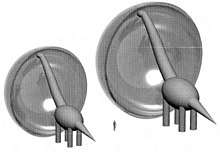
The nostrils of Giraffatitan, like the huge corresponding nasal openings in its skull, were long thought to be located on the top of the head. In past decades, scientists theorized that the animal used its nostrils like a snorkel, spending most of its time submerged in water in order to support its great mass. The current consensus view, however, is that Giraffatitan was a fully terrestrial animal. Studies have demonstrated that water pressure would have prevented the animal from breathing effectively while submerged and that its feet were too narrow for efficient aquatic use. Furthermore, new studies by Lawrence Witmer (2001) show that, while the nasal openings in the skull were placed high above the eyes, the nostrils would still have been close to the tip of the snout (a study which also lends support to the idea that the tall "crests" of brachiosaurs supported some sort of fleshy resonating chamber).
Brain
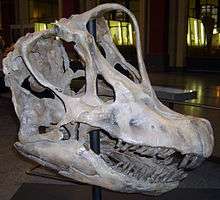
Giraffatitan's brain measured about 300 cubic centimetres, which, like those of other sauropods, was small compared to its massive body size. A 2009 study calculated its Encephalization Quotient (a rough estimate of possible intelligence) at a low 0.62 or 0.79, depending on the size estimate used. Like other sauropods, Giraffatitan has a sacral enlargement above the hip which some older sources misleadingly referred to as a "second brain".[16] However, glycogen bodies are a more likely explanation.[17]
Metabolism
If Giraffatitan was endothermic (warm-blooded), it would have taken an estimated ten years to reach full size, if it were instead poikilothermic (cold-blooded), then it would have required over 100 years to reach full size.[18] As a warm-blooded animal, the daily energy demands of Giraffatitan would have been enormous; it would probably have needed to eat more than ~182 kg (400 lb) of food per day. If Giraffatitan was fully cold-blooded or was a passive bulk endotherm, it would have needed far less food to meet its daily energy needs. Some scientists have proposed that large dinosaurs like Giraffatitan were gigantotherms.[19] Internal organs of these giant sauropods were probably enormous.[20]
Paleoecology

Giraffatitan lived in what is now Tanzania in the Late Jurassic Tendaguru Formation.[21] Since 2012, the boundary between the Kimmeridgian and Tithonian is dated at 152.1 million years ago.[22]
The Tendaguru ecosystem primarily consisted of three types of environment: shallow, lagoon-like marine environments, tidal flats and low coastal environments; and vegetated inland environments. The marine environment existed above the fair weather wave base and behind siliciclastic and ooid barriers. It appeared to have had little change in salinity levels and experienced tides and storms. The coastal environments consisted of brackish coastal lakes, ponds and pools. These environments had little vegetation and were probably visited by herbivorous dinosaurs mostly during droughts. The well vegetated inlands were dominated by conifers. Overall, the Late Jurassic Tendaguru climate was subtropical to tropical with seasonal rains and pronounced dry periods. During the Early Cretaceous, the Tendaguru became more humid.[23] The Tendaguru Beds are similar to the Morrison Formation of North America except in its marine interbeds.[24]
Giraffatitan would have coexisted with fellow sauropods like Dicraeosaurus hansemanni and D. sattleri, Janenschia africana, Tendaguria tanzaniensis and Tornieria africanus; ornithischians like Dysalotosaurus lettowvorbecki and Kentrosaurus aethiopicus; the theropods "Allosaurus" tendagurensis, "Ceratosaurus" roechlingi, "Ceratosaurus" ingens, Elaphrosaurus bambergi, Veterupristisaurus milneri and Ostafrikasaurus crassiserratus; and the pterosaur Tendaguripterus recki.[25][26][27][28] Other organisms that inhabited the Tendaguru included corals, echinoderms, cephalopods, bivalves, gastropods, decapods, sharks, neopterygian fish, crocodilians and small mammals like Brancatherulum tendagurensis.[29]
References
- 1 2 3 4 Janensch, W (1914). "Übersicht über der Wirbeltierfauna der Tendaguru-Schichten nebst einer kurzen Charakterisierung der neu aufgeführten Arten von Sauropoden". Archiv für Biontologie. 3 (1): 81–110.
- ↑ Janensch, Werner (1950). "Die Wirbelsäule von Brachiosaurus brancai". Palaeontographica. Supplement 7: 27–93.
- 1 2 3 4 5 6 Taylor, M.P. (2009). "A Re-evaluation of Brachiosaurus altithorax Riggs 1903 (Dinosauria, Sauropod) and its generic separation from Giraffatitan brancai (Janensch 1914)" (PDF). Journal of Vertebrate Paleontology. 29 (3): 787–806. doi:10.1671/039.029.0309.
- 1 2 Mazzetta, G.V.; et al. (2004). "Giants and Bizarres: Body Size of Some Southern South American Cretaceous Dinosaurs". Historical Biology. 16: 1–13. doi:10.1080/08912960410001715132.
- ↑ Janensch, W. (1950). "The Skeleton Reconstruction of Brachiosaurus brancai": 97–103.
- ↑ Russell, D.; Béland, P.; McIntosh, J.S. (1980). "Paleoecology of the dinosaurs of Tendaguru (Tanzania)". Mémoires de la Societé géologique de la France. 59: 169–175.
- ↑ Colbert, E (1962). "The weights of dinosaurs". American Museum Novitates. 2076: 1–16.
- ↑ Paul, G.S. (1988). "The brachiosaur giants of the Morrison and Tendaguru with a description of a new subgenus, Giraffatitan, and a comparison of the world's largest dinosaurs". Hunteria. 2 (3): 1–14.
- ↑ Benson, R. B. J.; Campione, N. S. E.; Carrano, M. T.; Mannion, P. D.; Sullivan, C.; Upchurch, P.; Evans, D. C. (2014). "Rates of Dinosaur Body Mass Evolution Indicate 170 Million Years of Sustained Ecological Innovation on the Avian Stem Lineage". PLoS Biology. 12 (5): e1001853. doi:10.1371/journal.pbio.1001853. PMC 4011683. PMID 24802911.
- ↑ Holtz, Thomas R. Jr. (2008) Dinosaurs: The Most Complete, Up-to-Date Encyclopedia for Dinosaur Lovers of All Ages Supplementary Information
- ↑ Witmer, L.M. (2001). "Nostril position in dinosaurs and other vertebrates and its significance for nasal function" (PDF). Science. 293 (5531): 850–853. doi:10.1126/science.1062681. PMID 11486085. Archived from the original (PDF) on 2013-09-06.
- ↑ Naish, D. (March 20, 2009). "Junk in the trunk: why sauropod dinosaurs did not possess trunks". ScienceBlogs. Archived from the original on 2012-01-13.
- ↑ Glut, D.F. (1997). "Brachiosaurus". Dinosaurs: The Encyclopedia. McFarland & Company. p. 218. ISBN 0-89950-917-7.
- ↑ Carpenter, K. and Tidwell, V. (1998). "Preliminary description of a Brachiosaurus skull from Felch Quarry 1, Garden Park, Colorado." Pp. 69–84 in: Carpenter, K., Chure, D. and Kirkland, J. (eds.), The Upper Jurassic Morrison Formation: An Interdisciplinary Study. Modern Geology, 23(1-4).
- ↑ D'emic, Michael D. (2012). "The early evolution of titanosauriform sauropod dinosaurs". Zoological Journal of the Linnean Society. 166 (3): 624–671. doi:10.1111/j.1096-3642.2012.00853.x.
- ↑ Knoll, F. and Schwarz-Wings, D. (2009). "Palaeoneuroanatomy of Brachiosaurus. Annales de Paléontologie, doi:10.1016/j.annpal.2009.06.001
- ↑ Giffin, Emily B. (1990). "Gross Spinal Anatomy and Limb Use in Living and Fossil Reptiles". Palaeobiology. 16 (4): 448–485. ISSN 0094-8373. JSTOR 2400969.
- ↑ Case, T.J. (1978). "Speculations on the Growth Rate and Reproduction of Some Dinosaurs". Paleobiology. 4 (3): 323.
- ↑ Bailey, J.B. (1997). "Neural spine elongation in dinosaurs: Sailbacks or buffalo-backs?". Journal of Paleontology. 71 (6): 1124–1146. doi:10.1017/s0022336000036076.
- ↑ http://dinosaurusblog.com/2016/07/04/jak-velke-vnitrni-organy-meli-obri-sauropodi/
- ↑ Robert Bussert, Wolf-Dieter Heinrich and Martin Aberhan, 2009, "The Tendaguru Formation (Late Jurassic to Early Cretaceous, southern Tanzania): definition, palaeoenvironments, and sequence stratigraphy", Fossil Record 12(2) 2009: 141–174
- ↑ Gradstein, F.M.; Ogg, J.G.; Schmitz, M.D. & Ogg, G.M., 2012, A Geologic Time Scale 2012, Elsevier
- ↑ Aberhan, Martin; Bussert, Robert; Heinrich, Wolf-Dieter; Schrank, Eckhart; Schultka, Stephan; Sames, Benjamin; Kriwet, Jürgen; Kapilima, Saidi (2002). "Palaeoecology and depositional environments of the Tendaguru Beds (Late Jurassic to Early Cretaceous, Tanzania)". Fossil Record. 5 (1): 19–44. doi:10.1002/mmng.20020050103.
- ↑ Mateus, Octávio (2006). "Late Jurassic dinosaurs from the Morrison Formation (USA), the Lourinhā and Alcobaça formations (Portugal), and the Tendaguru Beds (Tanzania): a comparison". In Foster, J.R.; Lucas, S.G. Paleontology and Geology of the Upper Morrison Formation. New Mexico Museum of Natural History and Science (bulletin 36). pp. 223–232. ISSN 1524-4156.
- ↑ Weishampel, David B; et al. (2004). "Dinosaur distribution (Late Jurassic, Africa)." In: Weishampel, David B.; Dodson, Peter; and Osmólska, Halszka (eds.): The Dinosauria, 2nd, Berkeley: University of California Press. p. 552. ISBN 0-520-24209-2.
- ↑ Barrett, P.M., Butler, R.J., Edwards, N.P., & Milner, A.R. Pterosaur distribution in time and space: an atlas. p61–107. in Flugsaurier: Pterosaur papers in honour of Peter Wellnhofer. 2008. Hone, D.W.E., and Buffetaut, E. (eds). Zitteliana B, 28. 264pp.
- ↑ Rauhut, Oliver W. M. (2011). "Theropod dinosaurs from the Late Jurassic of Tendaguru (Tanzania)". Special Papers in Palaeontology. 86: 195–239. doi:10.1111/j.1475-4983.2011.01084.x.
- ↑ Buffetaut, Eric (2012). "An early spinosaurid dinosaur from the Late Jurassic of Tendaguru (Tanzania) and the evolution of the spinosaurid dentition". Oryctos. 10: 1–8.
- ↑ Heinrich, Wolf-Dieter; et al. (2001). "The German‐Tanzanian Tendaguru Expedition 2000" (PDF). Fossil Record. 4 (1): 223–237. doi:10.1002/mmng.20010040113.
External links

